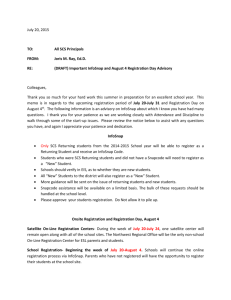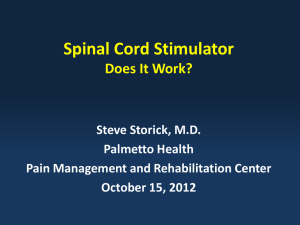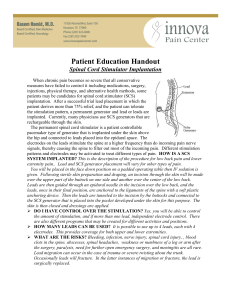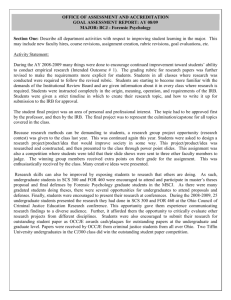Quality Management of Short Courses at Higher Education Institutions in... A Comparative Study
advertisement
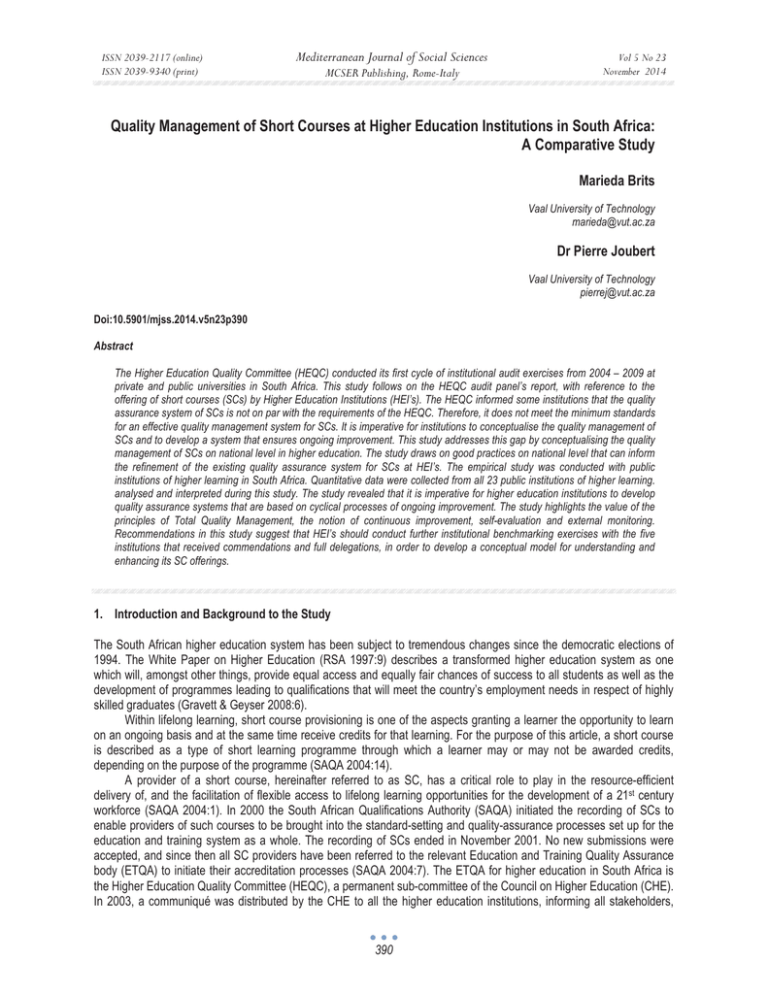
ISSN 2039-2117 (online) ISSN 2039-9340 (print) Mediterranean Journal of Social Sciences MCSER Publishing, Rome-Italy Vol 5 No 23 November 2014 Quality Management of Short Courses at Higher Education Institutions in South Africa: A Comparative Study Marieda Brits Vaal University of Technology marieda@vut.ac.za Dr Pierre Joubert Vaal University of Technology pierrej@vut.ac.za Doi:10.5901/mjss.2014.v5n23p390 Abstract The Higher Education Quality Committee (HEQC) conducted its first cycle of institutional audit exercises from 2004 – 2009 at private and public universities in South Africa. This study follows on the HEQC audit panel’s report, with reference to the offering of short courses (SCs) by Higher Education Institutions (HEI’s). The HEQC informed some institutions that the quality assurance system of SCs is not on par with the requirements of the HEQC. Therefore, it does not meet the minimum standards for an effective quality management system for SCs. It is imperative for institutions to conceptualise the quality management of SCs and to develop a system that ensures ongoing improvement. This study addresses this gap by conceptualising the quality management of SCs on national level in higher education. The study draws on good practices on national level that can inform the refinement of the existing quality assurance system for SCs at HEI’s. The empirical study was conducted with public institutions of higher learning in South Africa. Quantitative data were collected from all 23 public institutions of higher learning. analysed and interpreted during this study. The study revealed that it is imperative for higher education institutions to develop quality assurance systems that are based on cyclical processes of ongoing improvement. The study highlights the value of the principles of Total Quality Management, the notion of continuous improvement, self-evaluation and external monitoring. Recommendations in this study suggest that HEI’s should conduct further institutional benchmarking exercises with the five institutions that received commendations and full delegations, in order to develop a conceptual model for understanding and enhancing its SC offerings. 1. Introduction and Background to the Study The South African higher education system has been subject to tremendous changes since the democratic elections of 1994. The White Paper on Higher Education (RSA 1997:9) describes a transformed higher education system as one which will, amongst other things, provide equal access and equally fair chances of success to all students as well as the development of programmes leading to qualifications that will meet the country’s employment needs in respect of highly skilled graduates (Gravett & Geyser 2008:6). Within lifelong learning, short course provisioning is one of the aspects granting a learner the opportunity to learn on an ongoing basis and at the same time receive credits for that learning. For the purpose of this article, a short course is described as a type of short learning programme through which a learner may or may not be awarded credits, depending on the purpose of the programme (SAQA 2004:14). A provider of a short course, hereinafter referred to as SC, has a critical role to play in the resource-efficient delivery of, and the facilitation of flexible access to lifelong learning opportunities for the development of a 21st century workforce (SAQA 2004:1). In 2000 the South African Qualifications Authority (SAQA) initiated the recording of SCs to enable providers of such courses to be brought into the standard-setting and quality-assurance processes set up for the education and training system as a whole. The recording of SCs ended in November 2001. No new submissions were accepted, and since then all SC providers have been referred to the relevant Education and Training Quality Assurance body (ETQA) to initiate their accreditation processes (SAQA 2004:7). The ETQA for higher education in South Africa is the Higher Education Quality Committee (HEQC), a permanent sub-committee of the Council on Higher Education (CHE). In 2003, a communiqué was distributed by the CHE to all the higher education institutions, informing all stakeholders, 390 ISSN 2039-2117 (online) ISSN 2039-9340 (print) Mediterranean Journal of Social Sciences MCSER Publishing, Rome-Italy Vol 5 No 23 November 2014 “SAQA has indicated that it would like all SCs, which are offered by higher education institutions to be quality assured by the relevant ETQAs” (CHE 2003). The HEQC clearly states that institutions should seek to establish and sustain reliable information for internal quality-related planning, external audit and public reporting (CHE 2004b:5). The HEQC has statutory responsibility for conducting institutional audits and accreditation of Higher Education programmes as laid down in the Higher Education Act of 1994 (CHE 2007:4). As a result, the HEQC developed a national system for institutional audits on a six-year cycle, whereby quality assurance mechanisms of HEIs are audited. Over and above this function, the HEQC had oversight responsibility for quality assurance arrangements in the following areas: SCs, certification arrangements, moderation of assessment, assessor training and development, and recognition of prior learning (Bhengu 2008). It was, therefore, a delegated function of HEIs to develop, implement and maintain the quality management of these functions. Consequently, the HEQC would grant accreditation to institutions with regard to the offering of SCs based on the effectiveness of a respective institution’s quality management system for the particular area. Therefore, a request was made for HEIs to develop and maintain an effective quality assurance system, hereinafter referred to as QAS, for the above-mentioned functions. Within the Vaal University of Technology (VUT), the Quality Promotion Unit (QPU) developed a centralised-decentralised institutional QAS based on internal self-evaluation and external monitoring. In May 2006 the HEQC conducted, as part of the Cycle 1 HEQC institutional audit exercises (from 2004 - 2009), an institutional audit at the VUT, after which an audit report was generated by the external review committee of the HEQC (CHE 2007:4). This report reflects the audit findings based on the validation of the Audit Portfolio (institutional selfevaluation report) provided by the VUT. The HEQC audit exercise follows a developmental approach. Therefore, audit recommendations and commendations in the audit report help institutions to strengthen their internal quality management systems, hereinafter referred to as QMS, as it feeds into planning processes on all institutional levels. In October 2008, the HEQC introduced its Framework for Delegated Functions (CHE 2008), which provides institutions with directives for the assessment of the effectiveness of their internal mechanism in relation to, amongst others, SCs. Following the audit report, the institution received a letter from the Deputy Executive Director of the HEQC. This letter informs the VUT that, amongst other things, it should maintain or improve on the state of its QMS for delegated functions; the HEQC reserves the right to investigate any deterioration of its QMS; and the HEQC reserves the right to withdraw the delegation of any of these functions should they determine that the institution no longer meets the criteria specified in the HEQC Framework for Delegated Functions (Bhengu 2008). In 2009, the VUT received a follow-up letter from the Deputy Executive Director of the HEQC, informing them that the quality management, hereinafter referred to as QM, of SCs “have not been adequately addressed in the institution’s improvement plan” and should thus be refined (Bhengu 2009). In February 2012, the CHE informed all institutions of higher learning about the cessation of delegation of specified quality assurance functions (Hay 2012). The letter states that, “the functions that the Higher Education Quality Committee (HEQC) previously delegated to higher education institutions in fulfilment of its role as the Education and Training Quality Assurer (ETQA) for higher education in terms of the SAQA Act no longer hold.” Consequently, the HEQC will no longer require HEIs to submit a portfolio of evidence of their quality assurance of the delegated functions. The letter further states that institutions will now be required to report on the previously delegated functions, as part of the implementation of the different quality assurance frameworks of the HEQC. This implies that SCs, a previously delegated function, will now form part of the institutional audit conducted by the HEQC. SCs, therefore, continue to be reflected in the criteria and minimum standards of the HEQC’s QAS. It was evident that a need exist for the conceptualisation of the QM of SCs at the VUT. As a result, the researcher conducted a benchmarking exercise with HEIs with a view to implementing a SC QAS, which is on par with the HEQC’s requirements. The outcome of the benchmarking informed the VUT on best practices of a QAS for SCs in order to develop an effective QMS for SCs at the VUT. 2. Methodology In this study, data collection was conducted by means of a quantitative research method. A survey design was employed, which involved the use of a questionnaire as data collection method. The questionnaire was divided into three sections. Section A dealt with institutional information including the profile of the respondent and covered aspects such as, position held in the department, work experience, a description of the respective SC or quality office and the university at which the participant is employed. Section B consisted of Yes/No questions that enabled respondents to reflect on the HEQC audit at their institution. Section C contained a range of survey questions. These questions seek to obtain the views or perceptions of 391 ISSN 2039-2117 (online) ISSN 2039-9340 (print) Mediterranean Journal of Social Sciences MCSER Publishing, Rome-Italy Vol 5 No 23 November 2014 respondents on the quality management aspects of SCs, within their respective department. Nine questions in Section C of the questionnaire were informed by the minimum standards and requirements of the HEQC (CHE 2008), whilst the remainder of the questions (17 questions) reflect on institutional procedures and systems for the quality management of SC. This study was conducted within the SC and/or Quality Assurance or Quality Management offices of HEIs in SA. The majority of HEIs have dedicated officers and structures for the management, monitoring and coordination of the quality assurance of SCs. It was, therefore, possible to collect information from relevant and informed institutional staff members by means of quantitative research methods. The target population was restricted to the managers or relevant dedicated officers of the respective SC office or designated quality managers at institutions of higher learning in SA, to identify best practices on national level. All 23 universities were invited to participate in the research, including 11 traditional universities, six universities of technology and six comprehensive universities. Twenty-three questionnaires were distributed and nineteen completed questionnaires were returned, resulting in a response rate of 82 percent. 3. Results The HEQC audit reports utilise the concepts ‘recommendations’ and ’commendations’. 42 percent (n=8) of the institutions that participated in the research did receive a commendation from the HEQC on the QM of SCs whilst 58 percent (n=11) reported that they did not receive a commendation. A commendation is an indication that the audit panel acknowledge ‘good practice’ with regard to a function that was audited. Therefore, the assumption can be made that an institution that receives a commendation for SCs has an effective QMS in place. It is important for the purpose of this study to identify those institutions that received commendations and full delegation of SCs (inter alia, QMS for SCs are on par with the minimum standards of the HEQC) and to identify their best practice with regard to the quality assurance and management of SCs. Therefore only 42 percent of the institutions that were audited can be viewed as institutions that implement best practice (according to the decision of the HEQC audit panels) with regard to the QM of their SC function. The HEQC fully delegated the SC function to 32 percent (n=6) of the institutions whilst 68 percent (n=13) of the institution’s SC function did not meet the minimum standards of the HEQC for SCs. The outcome of this comparison of institutions that received commendations and delegations informs the researcher’s attempt to identify institutions with good practice. Five institutions can be regarded as institutions with good practice with regard to their QM of SCs, as they received both commendations and full delegations. 79 percent of the respondents agree that their institution has arrangements in place to monitor the implementation of the SC policy while 68 percent of the respondents agree that the mechanisms for the QA of SCs are widely known in the institution. The majority of respondents (84%) are of the opinion that a system is in place for regular reviews of SCs and that a quality management model for continuous improvement of SCs exist. Only 5 percent of the respondents disagree that their institution has mechanisms and processes in place for the approval of SCs by an appropriate governance structure and 11 percent disagree that planning for the provision of SCs takes into account a range of issues. 32 percent of respondents disagree that the QAS at their institution is effective for identifying deficiencies and gaps that hamper the quality of SC programmes. 37 percent of the respondents disagree that the outcome of QA processes of reviews feed into remedial action plans to ensure continuous improvement. It is, unfortunately not clear, if the problem of integration appears on operational or strategic levels, or on both of these levels at the relevant institutions. 58 percent of the respondents agree that the management of SCs is underpinned by PDCA/ADRI models and 53 percent agree to the statement that there is more than one approach to the QM of SCs. 37 percent of respondents disagreed with the statement that it is the faculty’s responsibility to implement systems to ensure quality enhancement of SCs which indicates that the responsibility for the enhancement of the quality of SCs resides with other structures (for example, the quality management office). 42 percent of the respondents reported that the head of the SC office has overall accountability for the implementation of a QMS for SCs and 79 percent agree to the statement that a SC register is in place. The majority (84%) of the respondents agree that SC certificates are issued on par with the relevant policy for certification processes. The same percentage agreed that arrangements are in place that ensure the integrity of learner records and certification processes. Almost an equal amount of respondents either agreed (47%) or disagreed (53%) that they improved their QMS by means of benchmarking with other institutions. The majority (63%) of respondents disagree to the statement that there are no concerns with regard to the QM of SCs. 392 ISSN 2039-2117 (online) ISSN 2039-9340 (print) Mediterranean Journal of Social Sciences Vol 5 No 23 November 2014 MCSER Publishing, Rome-Italy 42 percent of respondents disagree with the statement that their quality management system for SC is on par with good practice, while 63 percent of respondents agree that they report to Senate on the offering of SC programmes. The majority (84%) agreed that Senate approves the offering of credit bearing SCs. 84 percent of the respondents agree that a faculty committee approves new SC proposals while 74 percent of respondents agree that credit bearing SC certificates are signed by the appropriate level of accountability at the institution. The majority (84%) of respondents positively indicated that an evaluation of participants’ learning experiences is conducted after completion of each SC. Only 58 percent of respondents agree that a SC brochure is available at their institution even though all respondents (100%) agree that their institution has a policy for SC management. 3.1 Results of HEIs with possible best practice: universities that received commendations and full delegation of SCs Four of the five institutions that received commendations and delegation for the QM of SCs are implementing cyclical processes of planning, doing, reviewing, adjusting and re-planning, in order to ensure continuous improvement. Not one of the five institutions’ QAS is, according to the respondents, effective to identify deficiencies. All five institutions indicated that they utilise the outcome of reviews for remedial action purposes. The majority of the five institutions have a QAS that is underpinned by the above-mentioned PDCA/ADRI model. The data with regard to the approach to quality management shows that three institutions follow a possible centralised-decentralised approach. It is evident that the five institutions have different systems in place for the quality management of SCs. This ranges from strong centralised approaches to variations of centralised-decentralised approaches. Three of the five institutions regard the quality management of its SCs as the responsibility of a central office or a SC manager. While the study indicates that there is a general lack of benchmarking exercises to improve quality management of SCs on institutional levels, the five institutions that most possibly implement best practice are utilising benchmarking exercises to inform the refinement of their quality management of SCs. There is therefore, a relation between the fact that they conduct benchmarking exercises and the improvement of their systems to a level of ‘good practice’. It is clear that only two of the five institutions report to Senate for the offering of their SC programmes, while all of the five institutions’ credit bearing courses is approved on Senate level. Three of the five institutions submit the approval of their non-accredit bearing programmes to Senate while four of the five institutions’ new SC proposals are approved on faculty levels. Four of the five institutions indicate that they usually conduct an evaluation of the participants’ course experience after completion of the SC which is on par with the findings of the majority (84%) of institutions that participated in this study. Only two of the five institutions have brochures available for SCs, this is on par with the findings of all the institutions that took part in the study, inter alia the majority institutions have information available that informs students on SC programmes. 3.2 Differences between types of HEIs If a quantifiable variable is divided into three or more distinct groups using a descriptive variable, one can assess the likelihood of these groups being different occurring by chance alone by using one-way analysis of variance or one-way ANOVA (Saunders, Lewis & Thornhill 2007:448). Therefore, this technique will test whether groups have different average scores. In this study, the three different types of HEIs (traditional universities, comprehensive universities and universities of technology) were tested for significant differences. The statistic used in ANOVA to determine statistical significance is the F-ratio (Bordens & Abbott 2011:443). Saunders et al. (2007:448) noted that if the likelihood of any difference between groups occurring by chance alone is low, this will be represented by a large F ratio with a probability value (p-value) of less than 0.05 – this is termed statistically significant. Table 1 illustrates that the F ratio value of 1.160 with two and 16 degrees of freedom (df) has a probability of occurrence, by chance alone, of less than 0.338 if there is no significant difference between the three groups. Table 1: Using ANOVA to indicate significant differences between the three types of HEIs Between Groups Within Groups Total Average Sum of Squares 1.560 10.758 12.318 393 df 2 16 18 Mean Square .780 .672 F 1.160 Sig. .338 ISSN 2039-2117 (online) ISSN 2039-9340 (print) Mediterranean Journal of Social Sciences MCSER Publishing, Rome-Italy Vol 5 No 23 November 2014 Therefore, the conclusion is that there is no statistically significant difference (F = 1.160, p>0.05) between the responses of the three different types of universities. Due to the fact that the level of significance was greater than 0.05, post hoc tests were deemed unnecessary. 4. Findings and Recommendations The majority of institutions that participated in this study are of the opinion that there are concerns with regard to the QM of SCs at their institutions. This is evident from an alarming 63 percent of HEIs that reported that they disagree with the statement that they have no concerns with regard to the QM of SCs. This concurs with the finding on the effectiveness of QMS for SCs. Although the majority of the institutions have QM and assurance systems in place, only 68 percent of the respondents are convinced that their systems are effective. This outcome agrees with the finding that 42 percent of respondents are of the opinion that their institution’s QMS for SCs is not on par with good practices. This finding emphasises the need and relevance of this study. Of importance is the finding that there is a general lack of benchmarking exercises to improve QM of SCs on institutional levels, except for the five institutions that most probably implement best practice. The data revealed that the institutions mentioned above are using benchmarking exercises to inform the refinement of the QM for SCs. The fact that the five institutions implement good practice would indicate there is a correlation between institutions that use benchmarking exercises to inform the refinement of the QM for SC, and the implementation of good practice. It appears that institutions that received commendations and delegations for SCs refine their systems through ongoing benchmarking exercises. Finding 1: The majority of institutions implemented quality management and assurance systems for SCs but the effectiveness of these systems are questionable. Finding 2: There is in general a lack of benchmarking practices with regard to SCs among HEIs. Finding 3: Benchmarking practices enhance the QM of SCs. Finding 4: There is a lack of implementation of continuous improvement models for SCs. Finding 5: The institutions that receive commendations and full delegations for the management of SCs implement models for continuous improvement. Finding 6: There is, in general, a lack of security arrangements to ensure authenticity of SC certificates. Finding 7: In general, staff has a lack of knowledge of the QAS and mechanisms for SCs. Finding 8: The implementation of an SC register is imperative for the effective management of SCs. Finding 9: A SC brochure is a valuable marketing mechanism that ensures effective communication and the students’ knowledge of courses. Finding 10: The majority of institutions developed and implemented approved policies for the offering of SCs. Recommendation 1: HEIs should benchmark with the five institutions that received commendations and full delegations in order to enhance its QM of SCs. Recommendation 2: HEIs should refine its QAS to implement a continuous improvement model (such as the PDCA, PIRI and ADRI models) that ensures cyclical processes for the enhancement of SCs. Recommendation 3: The Registrar and the Vice-Chancellor, or equivalent, should sign certificates for credit-bearing SCs. Institutions should embark upon establishing effective communication channels between the structures for SC management and faculties/departments. All relevant parties should receive communications on information such as mechanisms for regular review of the effectiveness of QMS for SCs. Recommendation 4: HEIs should develop and implement mechanisms that will ensure effective communication and knowledge of the QA of SCs. Recommendation 5: HEIs should have a register in place, which outlines, amongst other things, the purpose, nature and status of SCs. Recommendation 6: The SC register should be integrated into the management information system of HEIs in order to keep a record of courses, and to inform processes of planning, resource allocation, reviews and improvement. Recommendation 7: HEIs should develop and implement a SC brochure as a valuable tool of communication that will enhance the current and potential students’ knowledge of the institution and its SC offerings. Recommendation 8: HEIs should revise its policy for SCs and align it with best practices as identified in this study. Recommendation 9: The policy for SCs should be subjected to a continuous review process. Recommendation 10: HEIs should ensure that the policy is widely known by the relevant stakeholders. Recommendation 11: HEIs should ensure that mechanisms are in place, which ensures the effective monitoring of the implementation of the policy. 394 ISSN 2039-2117 (online) ISSN 2039-9340 (print) 5. Mediterranean Journal of Social Sciences MCSER Publishing, Rome-Italy Vol 5 No 23 November 2014 Limitations of the Study The QMS and internal structures for SCs of HEIs are diverse; it was, therefore, a challenge to design ‘generic-type’ questions that would provide sufficient data from the majority of participants. Therefore, the diverse nature of QMS of institutions in South Africa, as well as the limitations of close-ended questions, made it very difficult to formulate questions that address the characteristics of the diverse types of SC management systems. This resulted in a need by the researcher to obtain clarity or explanations of answers provided by some of the respondents. As an example, a few respondents wrote notes on the questionnaire to explain why their response was ‘moderately agree/disagree’ instead of ‘strongly agree/disagree’. This qualitative type of information was valuable during the interpretation of the data. One institution reported that it has three campuses and SCs are managed somewhat differently on each of the three campuses. Institutions that follow centralised-decentralised approaches might also have difficulties completing this ‘generic’ questionnaire. One of the respondents noted per e-mail that the question “Senate approves the offering of credit bearing SC”, needed more explanation. In this case, Senate approval is done indirectly, by having Senate representatives on appropriate committees, who consider and approve SC applications. An open-ended question might be the solution to this limitation. This emphasises the value of a ‘mixed approach’, inter alia applying quantitative and qualitative methodology to this type of study. 6. Implications for Future Research The findings from the study point toward several useful directions for future study.The implementation of a revised QAS for SCs will enhance the institution’s offering of SCs and contribute to the effective QM of SCs at VUT. It is envisaged that this study may result in a framework for the implementation of a QAS for SCs at VUT and the refinement of the current policy on SCs. It might also contribute to enhancing and conceptualising the QM of SC on national level for institutions that have an ineffective QAS. Therefore, this study can inform the development of a conceptual framework for understanding and enhancing SC quality management on national level. 7. Concluding Remarks The researcher identified institutions that received commendations and full delegation for SCs from the data gathered from respondents. The researcher regards these institutions as universities with possible best practices due to the positive outcome of their audits on QM during the Cycle one HEQC institutional audits. This study provides an overview of the diverse QM and quality assurance arrangements at HEIs in South Africa. Information on best practices at the institutions that participated in this study enabled the researcher to conduct a comparison study. The outcome of this comparison informs the researcher’s attempt to suggest recommendations to VUT on initiatives that will have a positive impact on the enhancement of the quality of its SC offerings. This empirical study is a contribution to VUT’s attempt to conceptualise and enhance the QM of its SC offerings, which is on par with the recommendation of the HEQC’s cycle one audit report. It can also feed, on national level, into the refinement of the SC quality management and assurance practices, given the fact that 63 percent of the respondents find this an area of concern. This study will benefit VUT if it is taken to a next level of re-planning of the QM and QAS of SCs, as part of the ongoing initiatives, which is characteristic of a TQM approach. Continuous benchmarking and comparative studies such as this one, are on par with VUT’s institutional QMS, which has a strong focus on continuous improvement and stakeholder satisfaction. Bibliography Bhengu, T. 2008. Letter to the Vice-Chancellor and Principal, 12 December. Pretoria (Original copy in the records of the Quality Promotion Unit, VUT) Bhengu, T. 2009. Letter to the Director: Quality Promotion Unit, 1 April. Pretoria (Original copy in the records of the Quality Promotion Unit, VUT) Bordens, K.S. & Abbott, B.B. 2011. Research design and methods: a process approach. 8th ed. New York: McGraw-Hill. Council on Higher Education. 2003. HEQC communiqué to higher education institutions and other stakeholders. Pretoria. Council on Higher Education. 2004b. Criteria for Institutional Audits. Pretoria. Council on Higher Education. 2008. HEQC Framework for Delegated Functions. Pretoria. Council on Higher Education Higher Education Quality Committee. 2007. Executive summary: Audit report on Vaal University of Technology. Pretoria: CHE. Gravett, S. & Geyser, H. 2008. Teaching and learning in higher education. Pretoria: Van Schaik Publishers. Hay, M. 2012. Letter to the Vice-Chancellor and Principal, 21 February. Pretoria (Original copy in the records of the Quality Promotion Unit, VUT) Republic of South Africa. Department of Education. 1997. White paper on higher education. Government Gazette 18207, 15 August. Saunders, M., Lewis, P. & Thornhill, A. 2007. Research methods for business students. 4th ed. London: Prentice Hall. South African Qualifications Authority. 2004. Criteria and guidelines for short courses and skills programmes. Pretoria. 395

